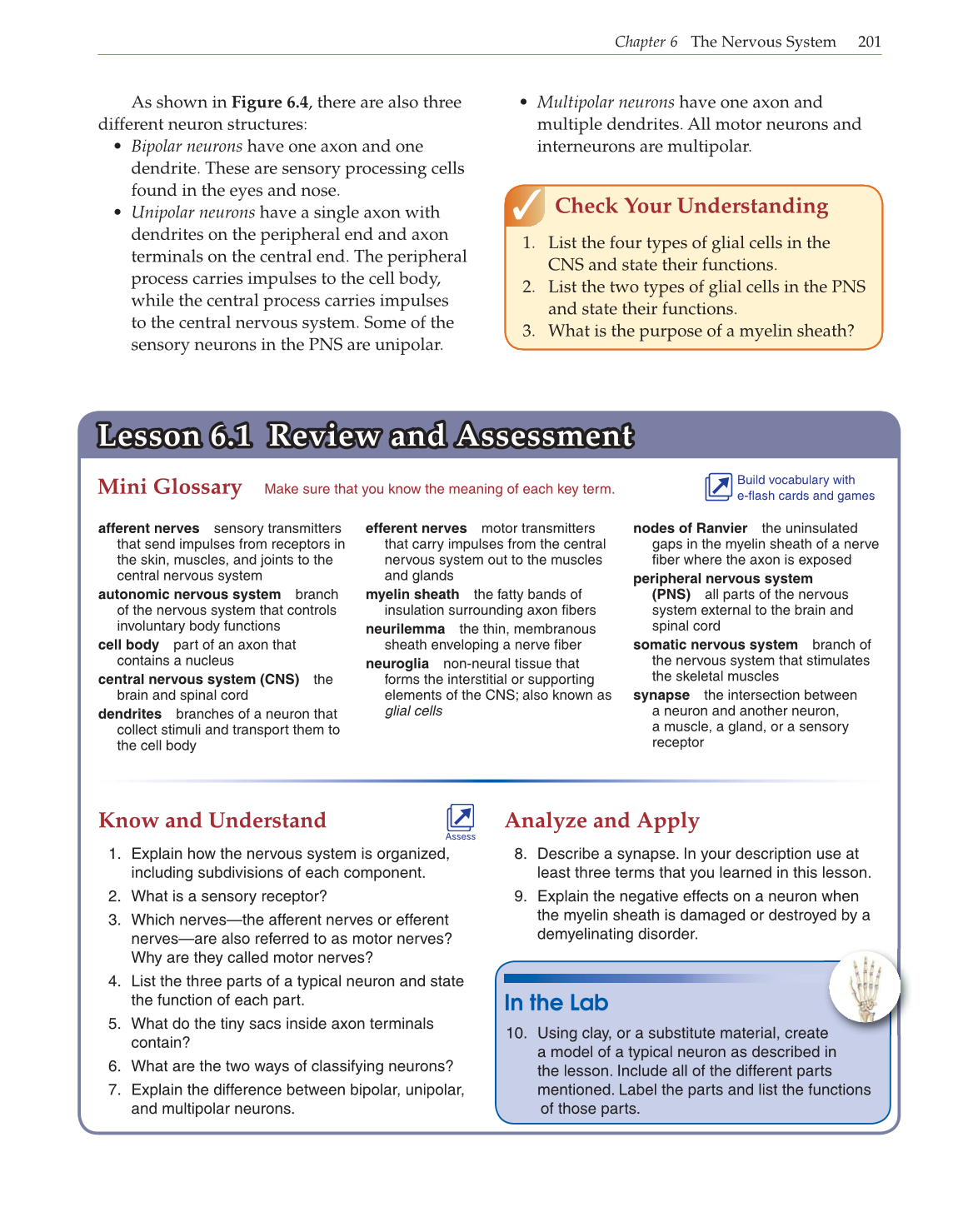Chapter 6 The Nervous System 201
As shown in Figure 6.4, there are also three
different neuron structures:
• Bipolar neurons have one axon and one
dendrite. These are sensory processing cells
found in the eyes and nose.
• Unipolar neurons have a single axon with
dendrites on the peripheral end and axon
terminals on the central end. The peripheral
process carries impulses to the cell body,
while the central process carries impulses
to the central nervous system. Some of the
sensory neurons in the PNS are unipolar.
Lesson 6.1 Review and Assessment Lesson 6.1 Review and Assessment
Mini Glossary
Make sure that you know the meaning of each key term.
Build vocabulary with
e-fl ash cards and games
afferent nerves sensory transmitters
that send impulses from receptors in
the skin, muscles, and joints to the
central nervous system
autonomic nervous system branch
of the nervous system that controls
involuntary body functions
cell body part of an axon that
contains a nucleus
central nervous system (CNS) the
brain and spinal cord
dendrites branches of a neuron that
collect stimuli and transport them to
the cell body
efferent nerves motor transmitters
that carry impulses from the central
nervous system out to the muscles
and glands
myelin sheath the fatty bands of
insulation surrounding axon fi bers
neurilemma the thin, membranous
sheath enveloping a nerve fi ber
neuroglia non-neural tissue that
forms the interstitial or supporting
elements of the CNS; also known as
glial cells
nodes of Ranvier the uninsulated
gaps in the myelin sheath of a nerve
fi ber where the axon is exposed
peripheral nervous system
(PNS) all parts of the nervous
system external to the brain and
spinal cord
somatic nervous system branch of
the nervous system that stimulates
the skeletal muscles
synapse the intersection between
a neuron and another neuron,
a muscle, a gland, or a sensory
receptor
Know and Understand
1. Explain how the nervous system is organized,
including subdivisions of each component.
2. What is a sensory receptor?
3. Which nerves—the afferent nerves or efferent
nerves—are also referred to as motor nerves?
Why are they called motor nerves?
4. List the three parts of a typical neuron and state
the function of each part.
5. What do the tiny sacs inside axon terminals
contain?
6. What are the two ways of classifying neurons?
7. Explain the difference between bipolar, unipolar,
and multipolar neurons.
Assess
Analyze and Apply
8. Describe a synapse. In your description use at
least three terms that you learned in this lesson.
9. Explain the negative effects on a neuron when
the myelin sheath is damaged or destroyed by a
demyelinating disorder.
10. Using clay, or a substitute material, create
a model of a typical neuron as described in
the lesson. Include all of the different parts
mentioned. Label the parts and list the functions
of those parts.
In the Lab
e
1. List the four types of glial cells in the
CNS and state their functions.
2. List the two types of glial cells in the PNS
and state their functions.
3. What is the purpose of a myelin sheath?
Check Your Understanding
• Multipolar neurons have one axon and
multiple dendrites. All motor neurons and
interneurons are multipolar.
